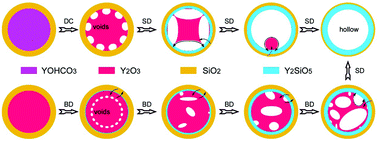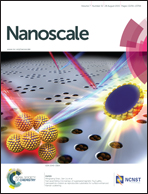Core-decomposition-facilitated fabrication of hollow rare-earth silicate nanowalnuts from core–shell structures via the Kirkendall effect†
Abstract
Hollow micro-/nanostructures have been widely applied in the fields of lithium ion batteries, catalysis, biosensing, biomedicine, and so forth. The Kirkendall effect, which involves a non-equilibrium mutual diffusion process, is one of many important fabrication strategies for the formation of hollow nanomaterials. Accordingly, full understanding of the interdiffusion process at the nanoscale is very important for the development of novel multifunctional hollow materials. In this work, hollow Y2SiO5 nanowalnuts have been fabricated from the conversion of YOHCO3@SiO2 core–shell nanospheres via the Kirkendall effect. More importantly, it was found that in the conversion process, the decomposition of YOHCO3 core imposes on the formation of the Y2SiO5 interlayer by facilitating the initial nucleation of the Kirkendall nanovoids and accelerating the interfacial diffusion of Y2O3@SiO2 core@shell. The simple concept developed herein can be employed as a general Kirkendall effect strategy without the assistance of any catalytically active Pt nanocrystals or gold motion for future fabrication of novel hollow nanostructures. Moreover, the photoluminescence properties of rare-earth ion doped hollow Y2SiO5 nanoparticles are researched.


 Please wait while we load your content...
Please wait while we load your content...